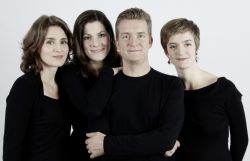|
Symphony
FROM THE NEW WORLD TO THE OLD WORLD
by Peter Lert
Saturday, June 14, 2025
Chamber
MC2 DUO RECITAL CLOSES 222'S SEASON
by Terry McNeill
Saturday, June 14, 2025
Choral and Vocal
CANTIAMO SONOMA'S LUSCIOUS A CAPELLA SINGING IN SEASON ENDING CONCERT
by Pamela Hicks Gailey
Sunday, June 8, 2025
Symphony
SRS SEASON ENDS WITH RESOUNDING TA-TA-TA-BANG
by Terry McNeill
Sunday, June 1, 2025
Symphony
YOUTHFUL VIRTUOSITY ON DISPLAY AT USO'S MAY CONCERTS
by Peter Lert
Saturday, May 17, 2025
Symphony
MYSTICAL PLANETS AND LIVELY GERSHWIN ORTIZ AT FINAL SRS CONCERT
by Peter Lert
Sunday, May 4, 2025
Symphony
VSO'S CONCERT MUSIC OF TIME, MUSIC OF PLACE
by Peter Lert
Sunday, April 27, 2025
VOCAL ELEGANCE AND FIRE AT THE 222'S RECITAL APRIL 26
by Pamela Hicks Gailey
Saturday, April 26, 2025
CANTIAMO SONOMA SINGS AN INSPIRED GOOD FRIDAY MOZART REQUIEM CONCERT
by Pamela Hicks Gailey
Friday, April 18, 2025
DRAMATIC SHOSTAKOVICH SYMPHONY CLOSES PHILHARMONIC'S 25TH SEASON
by Terry McNeill
Sunday, April 13, 2025
|
 |
 Tetzlaff Quartet |
TETZLAFF QUARTET'S MASTERY IN MOZART AND SCHUBERT
by Terry McNeill
Saturday, November 11, 2017
German violin virtuoso Christian Tetzlaff presented a critically successful Weill Hall recital Feb. 18, and returned to the same venue Nov. 11 with his admirable Tetzlaff Quartet in a program of Berg, Schubert and Mozart.
Clarity of ensemble has always been a hallmark of this Quartet, and contrapuntal clarity was in the forefront of their performance of Mozart’s E-Flat Major Quartet, K. 428. All of Mr. Tetzlaff’s trademarks were on display here: small ritards in the high register that drop quickly into decrescendo and chaste phrasing again high up that drops to pianissimo and hands the themes to colleagues. His musical partners were exemplary all night: Elizabeth Kufferath, violin; Hanna Weinmeister, viola; and cellist Tanja Tetzlaff.
Placing Ms. Tetzlaff stage left (unlike the Quartet’s photos and YouTube appearances) gave hefty but precise low string weight to the ensemble, and she played elegantly all evening. The romantic mood of the opening allegro was captured, and the Quartet had impeccable control of pianissimo in the quiet repeated four-note phrases. The andante and menuetto were equally well played, and Mr. Tetzlaff’s spiccato bow was nimble and the contrasting moods of the short trio were perfectly shaped.
The boisterous finale found Mr. and Ms. Tetzlaff in delicious duos with ample virtuosity and Mozartian insight. Always impressive was the way each instrument in the blend could grow the music in intensity, reminiscent of Haydn’s Quartets, from every volume level. It was a brilliant and mature interpretation.
Berg’s two-movement Quartet, Op. 3, closed the first half. This is a complex 20-minute contrapuntal work from 1910, atonal and full of leaps in the melodic lines. Ms. Weinmeister opened the piece with a touching lament and the entering strings used portamento effectively. Much of the playing underscored the shrill aspects of Berg’s music, though the Tetzlaff’s dynamic flexibility and ability to play soft and fading phrase endings diluted some of the strident string tone. Knotty rhythms were mastered in the finale, and Ms., Tetzlaff’s big cello statement in the coda seemed effortless, which of course in this music it was not.
Following intermission Schubert’s G Major Quartet (No. 15, D. 887) comprised the entire second half. It’s the composer’s last and longest quartet, and arguably the most difficult to keep together over its 45-minute duration. Stamina on the Tetzlaff, and certainly some in the audience of 350, is required. It was a wonderful performance and the Tetzlaff didn’t evidence a moment of fatigue. Their opening grabbed attention in a way that was almost orchestral in texture. Viola and Ms. Kufferath’s genteel violin line and tremolos paired with Mr. Tetzlaff’s interjecting notes and phrases to form sharp contrasts – elegiac background and often wild sound flights. The Quartet effortlessly and subtlety changed tempos throughout, surely needs in Schubert’s Quartets.
The scherzo was played at a judicious tempo with a lively but never frivolous charm. Here the composer has written many false cadences, and always he seems to have another idea to present. The lilting waltz theme was enticingly rendered with seductive charm, driving to a fast ending led by Mr. Tetzlaff’s magical bow and fingers. The repeats in the concluding allegro vivace each had a slightly different character, another seemingly standard feature of this ensemble’s magisterial control and technical finish.
Programing the protracted Schubert was a savvy choice, as chamber music aficionados were rewarded with a masterful performance that was in the end spiritual and fully encompassed the composer’s genius.
|
